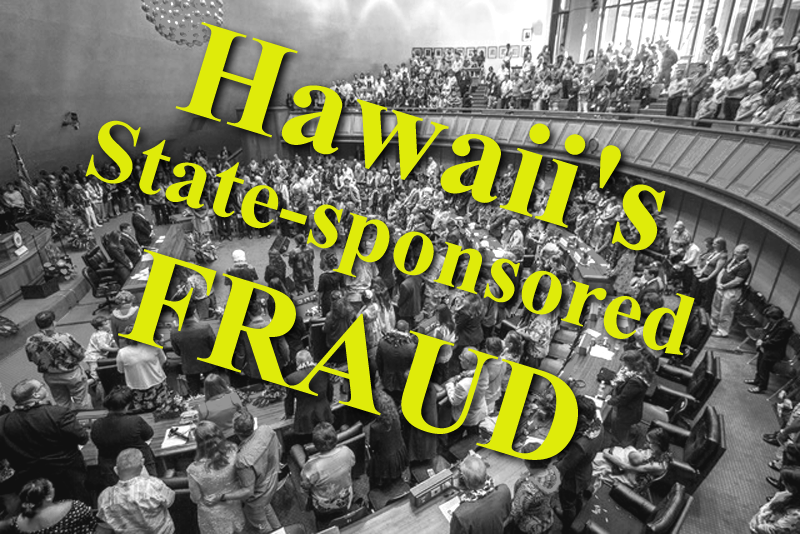When we questioned DLNR personnel about the ongoing fraud, we were met with a wall of silence
HON now has more than 18,000 subscribers (subscribe)
(Quick note to Anne Lopez, Hawaii’s latest version of Attorney General: Hi Anne, Please don’t worry yourself over this. Defrauding the public in Hawaii has long ago become normalized.)
The liveaboard waitlist scam:
The liveaboard waitlist and associated fees state-sponsored scam: the DLNR is currently accepting waitlist applications and their accompanying yearly fees from applicants wishing to place their name on the liveaboard waitlist. The applicant, of course, has the obvious expectation that the DLNR will, at some point in the waiting process, provide the promised permit that the waitlist application process implies. For some reason, the administrator of the Division of Boating and Ocean Recreation has been allowed to make, independently, an arbitrary and capricious change to Hawaii Revised Statues -- a single word change, from "should" to "may" -- that then somehow gives the DLNR the right to accept money in exchange for a waitlist application while at the same time having no intention of ever supplying a liveaboard permit.
The fraudulent flat rate electrical fees scam; the scheme to charge non-HECO monitored piers at the Ala Wai Small Boat harbor a non-scaling flat rate fee:
The electrical flat rate fees as per §13-234-10 for vessels on floating piers who are not on HECO electrical meters are not being charged on a sliding scale. Someone living on a small 25’ boat is paying the same $100 per month as those living on 60’ boats. Electricity is a consumption item and is usually charged for by the kilowatt hour of consumption. Many of our boaters are not consuming anywhere near $40 per month for regular tenants and $100 per month for liveaboard tenants. What happens to the windfall overages paid by boaters who consume nowhere near the amount of electricity that they’re being charged for? In the current scheme, the less affluent boater is subsidizing the more affluent. (See our in-depth coverage here)
The scheme to collect an additional month's fee from tenants (for an empty slip) who sell their vessels, transfer ownership, and then vacate their slips:
It is a well-known fact that it is impossible to predict a calendar day when the transfer of ownership will occur for the sale of any vessel in the state of Hawaii. Selling a boat in Hawaii, as is true elsewhere around the country, is unpredictable, at best.
To have a rule in place saying that a tenant must give 30 days notice to vacate their slip as a prerequisite to having their deposits and other fees returned to them upon leaving the harbor, as a result of the sale of their vessel, simply amounts to fraud, because the tenant is forced to pay for an extra month's slip fee for a slip that is vacant.
This is a scheme that is designed specifically to collect an additional month's rent for a vacant slip.
So, for example, if a tenant lists his/her boat for sale on Craigslist, the seller cannot in any way be guaranteed that 30 days from the listing of that vessel that there will actually occur a sale and a subsequent transfer of title resulting in the vacating of his/her slip. In fact, it is a well-known fact that an actual sale and then the subsequent transfer of title, which could occur at any time after that sale (or, as often happens, could actually fall through leaving the owner holding the boat in anticipation of another interested buyer) on the day that buyer and seller actually consummate a deal and subsequently transfer title of ownership. Obviously, completely unpredictable.
Yet the state of Hawaii requires tenants who are selling their boat to give them 30 days notice, in writing, of transfer of title before they are eligible to apply for a refund of all deposits and fees properly due relating to the previously occupied slip. This, of course, is nothing more than a scam to collect an extra month's rent on what now must be an unoccupied slip, as the tenant can only give notice of vacating his/her slip on the day -- unpredictable -- that that title actually transfers hands. On that day, the boat no longer belongs to the previous owner and the new owner must find another slip within the harbor system.
The problem associated with the timely return of a tenant's fees held, sometimes for decades, by the state of Hawaii, with no interest paid
And related to this same scam is the very real problem associated with the timely return of a tenant's fees held by the state of Hawaii with no interest paid for a period of up to or exceeding three months after an application request for a return of fees has been submitted. When asked by the tenant when their fees may be returned, harbor agents will often indicate that "after we get around to submitting your application for a refund, you may receive your money in the mail about three months after they receive your application in the main office". The tenant is then informed that there will be no interest paid on his/her money and that the actual return of his/her money, after being held by the state for a period of perhaps 10 or more years during the tenancy period, will be arbitrarily decided upon by the Department of Land and Natural Resources. Ironically, these same fees are demanded immediately and upfront before the issuance of a slip in the public's harbor system.
At the DLNR and in DOBOR offices, arrogance, smug disregard for the finances of the public, and outright fraud all seem to go hand-in-hand.

